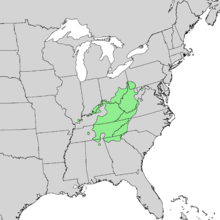bio.wikisort.org - Plant
Aesculus flava, the yellow buckeye, common buckeye, or sweet buckeye, is a species of deciduous tree. It is native to the Ohio Valley and Appalachian Mountains of the Eastern United States.[2] It grows in mesophytic forest or floodplains, generally in acid to circumneutral soil, reaching a height of 20m to 48m (65 ft to 154 ft).
Description
The leaves are palmately compound with five (rarely seven) leaflets, 10–25 cm long and broad. The flowers are produced in panicles in spring, yellow to yellow-green, each flower 2–3 cm long with the stamens shorter than the petals (unlike the related A. glabra (Ohio buckeye), where the stamens are longer than the petals). The twigs have a faintly rank odor, but much less so than the Ohio buckeye, A. glabra. The fruit is a smooth (spineless), round or oblong capsule 5–7 cm diameter, containing 1-3 nut-like seeds, 2.5-3.5 cm diameter, brown with a whitish basal scar. The fruit is poisonous to humans but can be made edible through a leaching process.
Cultivation
Aesculus flava is cultivated as an ornamental tree. The tree's showy yellow flowers and good autumn color are attractive in larger gardens and in parks.[3]
This plant has gained the Royal Horticultural Society's Award of Garden Merit.[4]
It has been marked as a pollinator plant that attracts hummingbirds and bees.[5]
Uses
Native Americans roasted and soaked the poisonous seeds to remove the toxic element and consume them as food.[6]
Photo gallery
Leaf Bark Spring bud break Fruit
References
- Stritch, L. (2018). "Aesculus flava". IUCN Red List of Threatened Species. 2018: e.T60757580A60757583. doi:10.2305/IUCN.UK.2018-1.RLTS.T60757580A60757583.en. Retrieved 12 November 2021.
- "Aesculus Octandra Range Map" (PDF). United States Geological Survey. Retrieved 2008-03-06.
- Missouri Botanical Garden horticultural treatment: Aesculus flava . accessed 1.31.2013
- "RHS Plant Selector - Aesculus flava". Retrieved 23 February 2020.
- "Planting Guides" (PDF). Pollinator.org. Retrieved 2022-01-29.
- Little, Elbert L. (1980). The Audubon Society Field Guide to North American Trees: Eastern Region. New York: Knopf. p. 586. ISBN 0-394-50760-6.
External links
| Wikimedia Commons has media related to Aesculus flava. |
- Yellow Buckeye Diagnostic images, Morton Arboretum acc. 12-U*1
- Bioimages.vanderbilt.edu — Aesculus flava photo gallery
- Ohio Buckeye Trivia Cards tell about the buckeye, buckeye tree, buckeye history, buckeye folklore and more.
На других языках
[de] Gelbe Rosskastanie
Die Gelbe Rosskastanie (Aesculus flava), auch Appalachen-Rosskastanie oder Gelbe Pavie genannt, ist eine Pflanzenart aus der Gattung der Rosskastanien (Aesculus). Sie ist in Nordamerika verbreitet und dort die größte und forstwirtschaftlich bedeutendste Rosskastanien-Art.- [en] Aesculus flava
[es] Aesculus flava
Aesculus flava (sin. Aesculus octandra), el falso castaño amarillo,[1] es una especie fanerógama perteneciente a la familia de las Sapindáceas. Es natural de Norteamérica del este Pensilvania, del oeste Illinois y del sur Alabama y Georgia.[ru] Конский каштан жёлтый
Ко́нский кашта́н жёлтый, или Конский каштан восьмитычи́нковый[2] (лат. Aesculus flava) — вид деревьев из рода Конский каштан семейства Конскокаштановые. Произрастает в Северной Америке[3].Другой контент может иметь иную лицензию. Перед использованием материалов сайта WikiSort.org внимательно изучите правила лицензирования конкретных элементов наполнения сайта.
WikiSort.org - проект по пересортировке и дополнению контента Википедии






